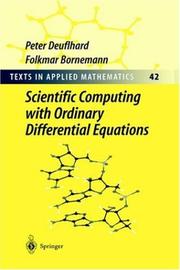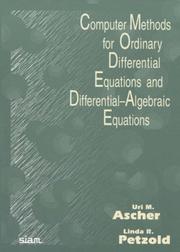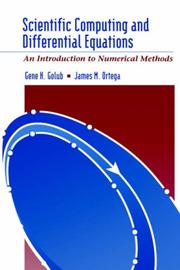| Listing 1 - 7 of 7 |
Sort by
|
Book
ISBN: 9781119018445 9781119018452 9781119018469 Year: 2016 Publisher: New York : Wiley
Abstract | Keywords | Export | Availability | Bookmark
 Loading...
Loading...Choose an application
- Reference Manager
- EndNote
- RefWorks (Direct export to RefWorks)
Uses mathematical, numerical, and programming tools to solve differential equations for physical phenomena and engineering problems Introduction to Computation and Modeling for Differential Equations, Second Edition features the essential principles and applications of problem solving across disciplines such as engineering, physics, and chemistry. The Second Edition integrates the science of solving differential equations with mathematical, numerical, and programming tools, specifically with methods involving ordinary differential equations; numerical methods for initial value problems (IVPs); numerical methods for boundary value problems (BVPs); partial differential equations (PDEs); numerical methods for parabolic, elliptic, and hyperbolic PDEs; mathematical modeling with differential equations; numerical solutions; and finite difference and finite element methods. The author features a unique “Five-M” approach: Modeling, Mathematics, Methods, MATLAB®, and Multiphysics, which facilitates a thorough understanding of how models are created and preprocessed mathematically with scaling, classification, and approximation and also demonstrates how a problem is solved numerically using the appropriate mathematical methods. With numerous real-world examples to aid in the visualization of the solutions, Introduction to Computation and Modeling for Differential Equations, Second Edition includes: New sections on topics including variational formulation, the finite element method, examples of discretization, ansatz methods such as Galerkin's method for BVPs, parabolic and elliptic PDEs, and finite volume methods Numerous practical examples with applications in mechanics, fluid dynamics, solid mechanics, chemical engineering, heat conduction, electromagnetic field theory, and control theory, some of which are solved with computer programs MATLAB and COMSOL Multiphysics® Additional exercises that introduce new methods, projects, and problems to further illustrate possible applications A related website with select solutions to the exercises, as well as the MATLAB data sets for ordinary differential equations (ODEs) and PDEs Introduction to Computation and Modeling for Differential Equations, Second Edition is a useful textbook for upper-undergraduate and graduate-level courses in scientific computing, differential equations, ordinary differential equations, partial differential equations, and numerical methods. The book is also an excellent self-study guide for mathematics, science, computer science, physics, and engineering students, as well as an excellent reference for practitioners and consultants who use differential equations and numerical methods in everyday situations.

ISBN: 0387954627 9780387954622 Year: 2002 Volume: 42 Publisher: New York: Springer,
Abstract | Keywords | Export | Availability | Bookmark
 Loading...
Loading...Choose an application
- Reference Manager
- EndNote
- RefWorks (Direct export to RefWorks)
Book
ISBN: 1441911642 1441911626 9786613569110 1441911634 1280391197 Year: 2010 Publisher: New York, NY : Springer New York : Imprint: Springer,
Abstract | Keywords | Export | Availability | Bookmark
 Loading...
Loading...Choose an application
- Reference Manager
- EndNote
- RefWorks (Direct export to RefWorks)
The book provides a comprehensive introduction to the theory of ordinary differential equations at the graduate level and includes applications to Newtonian and Hamiltonian mechanics. It not only has a large number of examples and computer graphics, but also has a complete collection of proofs for the major theorems, ranging from the usual existence and uniqueness results to the Hartman-Grobman linearization theorem and the Jordan canonical form theorem. The book can be used almost exclusively in the traditional way for graduate math courses, or it can be used in an applied way for interdisciplinary courses involving physics, engineering, and other science majors. For this reason an extensive computer component using Maple is provided on Springer’s website. This new edition has been extensively revised throughout, particularly the chapters on linear systems, stability theory and Hamiltonian systems. The computer component is an in-depth supplement and complement to the material in the text and contains an introduction to discrete dynamical systems and iterated maps, special-purpose Maple code for animating phase portraits, stair diagrams, N-body motions, and rigid-body motions, and numerous tutorial Maple worksheets pertaining to all aspects of using Maple to study the topics in the text. Review from first edition: "This book is intended for first- and second- year graduate students in mathematics and also organized to be used for interdisciplinary courses in applied mathematics, physics, and engineering. ... The book is well written and provides many interesting examples. The author gives a comprehensive introduction to the theory on ordinary differential equations with a focus on mechanics and dynamical systems. The exposition is clear and easily understood...." (Yuan Rong, Zentralblatt MATH, Vol. 993 (18), 2002).
Differential equations -- Data processing. --- Electronic books. -- local. --- Maple (Computer file). --- Differential equations --- Mechanics --- Hamiltonian systems --- Dynamics --- Vector fields --- Mathematics --- Physical Sciences & Mathematics --- Calculus --- Data processing. --- Maple (Computer file) --- 517.91 Differential equations --- Mathematics. --- Dynamics. --- Ergodic theory. --- Differential equations. --- Numerical analysis. --- Physics. --- Ordinary Differential Equations. --- Numerical Analysis. --- Dynamical Systems and Ergodic Theory. --- Mathematical Methods in Physics. --- Differential Equations. --- Differentiable dynamical systems. --- Mathematical physics. --- Physical mathematics --- Physics --- Differential dynamical systems --- Dynamical systems, Differentiable --- Dynamics, Differentiable --- Global analysis (Mathematics) --- Topological dynamics --- Mathematical analysis --- Vector fields. --- Mechanics. --- Hamiltonian systems. --- Dynamical systems --- Kinetics --- Mechanics, Analytic --- Force and energy --- Statics --- Natural philosophy --- Philosophy, Natural --- Physical sciences --- Ergodic transformations --- Continuous groups --- Mathematical physics --- Measure theory --- Transformations (Mathematics)
Book
ISBN: 9789401798167 940179815X 9789401798150 9401798168 Year: 2015 Publisher: Dordrecht : Springer Netherlands : Imprint: Springer,
Abstract | Keywords | Export | Availability | Bookmark
 Loading...
Loading...Choose an application
- Reference Manager
- EndNote
- RefWorks (Direct export to RefWorks)
This book introduces a variety of neural network methods for solving differential equations arising in science and engineering. The emphasis is placed on a deep understanding of the neural network techniques, which has been presented in a mostly heuristic and intuitive manner. This approach will enable the reader to understand the working, efficiency and shortcomings of each neural network technique for solving differential equations. The objective of this book is to provide the reader with a sound understanding of the foundations of neural networks, and a comprehensive introduction to neural network methods for solving differential equations together with recent developments in the techniques and their applications. The book comprises four major sections. Section I consists of a brief overview of differential equations and the relevant physical problems arising in science and engineering. Section II illustrates the history of neural networks starting from their beginnings in the 1940s through to the renewed interest of the 1980s. A general introduction to neural networks and learning technologies is presented in Section III. This section also includes the description of the multilayer perceptron and its learning methods. In Section IV, the different neural network methods for solving differential equations are introduced, including discussion of the most recent developments in the field. Advanced students and researchers in mathematics, computer science and various disciplines in science and engineering will find this book a valuable reference source.
Mathematics. --- Mathematical Models of Cognitive Processes and Neural Networks. --- Ordinary Differential Equations. --- Numerical and Computational Physics. --- Appl.Mathematics/Computational Methods of Engineering. --- Computational Mathematics and Numerical Analysis. --- Differential Equations. --- Computer science --- Engineering mathematics. --- Mathématiques --- Informatique --- Mathématiques de l'ingénieur --- Differential equations -- Data processing. --- Neural networks (Computer science). --- Engineering & Applied Sciences --- Computer Science --- Neural networks (Computer science) --- Differential equations --- Data processing. --- 517.91 Differential equations --- Artificial neural networks --- Nets, Neural (Computer science) --- Networks, Neural (Computer science) --- Neural nets (Computer science) --- Differential equations. --- Computer mathematics. --- Physics. --- Applied mathematics. --- Artificial intelligence --- Natural computation --- Soft computing --- Numerical and Computational Physics, Simulation. --- Mathematical and Computational Engineering. --- Computer mathematics --- Discrete mathematics --- Electronic data processing --- Engineering --- Engineering analysis --- Mathematical analysis --- Mathematics --- Neural networks (Computer science) . --- Natural philosophy --- Philosophy, Natural --- Physical sciences --- Dynamics

ISBN: 0898714125 9780898714128 Year: 1998 Publisher: Philadelphia (Pa.) : SIAM,
Abstract | Keywords | Export | Availability | Bookmark
 Loading...
Loading...Choose an application
- Reference Manager
- EndNote
- RefWorks (Direct export to RefWorks)
Differential equations --- Differential-algebraic equations --- Equations différentielles --- Data processing. --- Informatique --- Data processing --- 519.6 --- 681.3*G17 --- Computational mathematics. Numerical analysis. Computer programming --- Ordinary differential equations: boundary value problems; convergence and stability; error analysis; initial value problems; multistep methods; single step methods; stiff equations (Numerical analysis) --- 681.3*G17 Ordinary differential equations: boundary value problems; convergence and stability; error analysis; initial value problems; multistep methods; single step methods; stiff equations (Numerical analysis) --- 519.6 Computational mathematics. Numerical analysis. Computer programming --- Equations différentielles --- 517.91 Differential equations --- Algebraic-differential equations --- Differential-algebraic systems --- Equations, Algebraic-differential --- Equations, Differential-algebraic --- Systems, Differential-algebraic --- 517.91 --- Numerical solutions --- Numerical solutions&delete& --- Differential equations - Data processing --- Differential-algebraic equations - Data processing

ISBN: 0122892550 0080516696 9780122892554 9781493300518 Year: 1992 Publisher: Boston (Mass.) : Academic press,
Abstract | Keywords | Export | Availability | Bookmark
 Loading...
Loading...Choose an application
- Reference Manager
- EndNote
- RefWorks (Direct export to RefWorks)
Scientific Computing and Differential Equations: An Introduction to Numerical Methods, is an excellent complement to Introduction to Numerical Methods by Ortega and Poole. The book emphasizes the importance of solving differential equations on a computer, which comprises a large part of what has come to be called scientific computing. It reviews modern scientific computing, outlines its applications, and places the subject in a larger context. This book is appropriate for upper undergraduate courses in mathematics, electrical engineering, and computer scienceit is also well-suited to serve as a textbook for numerical differential equations courses at the graduate level. * An introductory chapter gives an overview of scientific computing, indicating its important role in solving differential equations, and placing the subject in the larger environment * Contains an introduction to numerical methods for both ordinary and partial differential equations * Concentrates on ordinary differential equations, especially boundary-value problems * Contains most of the main topics for a first course in numerical methods, and can serve as a text for this course * Uses material for junior/senior level undergraduate courses in math and computer science plus material for numerical differential equations courses for engineering/science students at the graduate level
Differential equations --- Numerical solutions --- Data processing. --- -519.6 --- 681.3*G17 --- Equations, Differential --- Bessel functions --- Calculus --- -Data processing --- Computational mathematics. Numerical analysis. Computer programming --- Ordinary differential equations: boundary value problems; convergence and stability; error analysis; initial value problems; multistep methods; single step methods; stiff equations (Numerical analysis) --- 681.3*G17 Ordinary differential equations: boundary value problems; convergence and stability; error analysis; initial value problems; multistep methods; single step methods; stiff equations (Numerical analysis) --- 519.6 Computational mathematics. Numerical analysis. Computer programming --- 517.91 Differential equations --- 519.6 --- Numerical solutions&delete& --- Data processing --- 517.91 --- Numerical solutions&delete&&delete& --- Differential equations - Numerical solutions - Data processing. --- Differential equations. Numerical solutions. Data --- Differential equations - - Data processing - Numerical solutions --- -517.91 --- -Differential equations --- -Differential equations. Numerical solutions. Data
Book
ISBN: 0136266061 9780136266068 Year: 1971 Publisher: Englewood Cliffs (N.J.): Prentice Hall,
Abstract | Keywords | Export | Availability | Bookmark
 Loading...
Loading...Choose an application
- Reference Manager
- EndNote
- RefWorks (Direct export to RefWorks)
Mathematics --- Differential equations --- Numerical integration --- Equations différentielles --- Data processing --- Informatique --- -Numerical integration --- Ordinary differential equations: boundary value problems; convergence and stability; error analysis; initial value problems; multistep methods; single step methods; stiff equations (Numerical analysis) --- 681.3*G17 Ordinary differential equations: boundary value problems; convergence and stability; error analysis; initial value problems; multistep methods; single step methods; stiff equations (Numerical analysis) --- 519.6 --- 681.3*G17 --- 519.6 Computational mathematics. Numerical analysis. Computer programming --- Computational mathematics. Numerical analysis. Computer programming --- Integration, Numerical --- Mechanical quadrature --- Quadrature, Mechanical --- Definite integrals --- Interpolation --- Numerical analysis --- 517.91 Differential equations --- 517.91 --- Numerical solutions --- Data processing. --- Mathematics. --- Numerical solutions&delete& --- Differential equations - Data processing --- Numerical integration - Data processing --- Acqui 2006
| Listing 1 - 7 of 7 |
Sort by
|

 Search
Search Feedback
Feedback About UniCat
About UniCat  Help
Help News
News